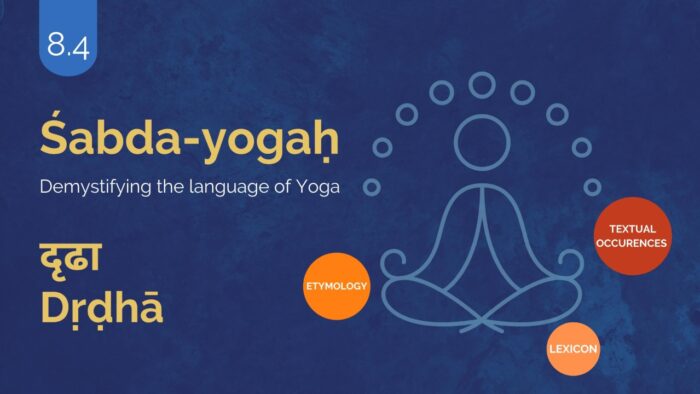Introduction
In this series, Yogic terminologies will be taken up and their -
- Etymological analysis,
- Lexical descriptions and
- Textual occurrences in Yogic literature and their commentaries, as available, will be presented. And finally observations will be made on the references.
Three texts - Yogasūtra, Haṭha-yoga-pradīpikā and Bhagavad-gītā are consulted for textual occurrences portion.
Śabda-yoga is intended to help students, teachers, and professionals of Yoga to develop a sound grammatical, contextual
8.4. Dṛḍhā
| Words of Unit 8 | |
| 8.1 | Sthitiḥ |
| 8.2 | Yatnaḥ |
| 8.3 | Satkāraḥ |
| 8.4 | Dṛḍhā |
| 8.5 | Bhūmiḥ |
From the among the five words for this unit 8, this part discusses the fourth word Dṛḍha.
Etymology
दृह्+क्त = दृढा
dṛh+kta = dṛḍhā
- The root is दृह् dṛh means वृद्धि vṛddhi - to grow, prosper
- The suffix is क्त The emergent form is an irregular form.
Though the suffix and root word are clear, the meaning and form are directly given by the grammatical treatise aṣṭādhyāyī. The grammatical rule states दृढः स्थूलबलयोः dṛḍhaḥ sthūlabalayoḥ (7.2.20)- the word dṛḍha is to be used to indicate the meaning - stout and strong. Because of the peculiarity of formation, there cannot be a derivative statement.
Lexicon
There are three entries in Amarakośa for this word
तीव्रैकान्तनितान्तानि गाढबाढदृढानि च 1.1.67
tīvraikāntanitāntāni gāḍhabāḍhadṛḍhāni ca
The words tīvra, ekānta, nitānta, gāḍha, bāḍha, dṛḍha all refer to things that are in - excess.
खक्खटं कठिनं क्रूरं कठोरं निष्ठुरं दृढम् 3.1.76
khakkhaṭaṃ kaṭhinaṃ krūraṃ kaṭhoraṃ niṣṭhuraṃ dṛḍham
The words khakkhaṭa, kaṭhina, krūra, kaṭhora, niṣṭhura, dṛḍha refer to things that are - tough
शक्तस्थूलौ त्रिषु दृढौ व्यूढौ विन्यस्तसंहतौ 3.3.45
śaktasthūlau triṣu dṛḍhau vyūḍhau vinyastasaṃhatau
dṛḍha, vyūḍha, vinyasta, saṃhata are used in two meanings - capable and stout
Thus as evident, to the word dṛḍha - the lexicon gives four meanings - excess, tough, capable and stout. It would be interesting to the meaning of the word in the Yogic context.
Textual occurrences
Yogasūtra
There is just one occurrence of the word in this text.
स तु दीर्घकालनैरन्तर्यसत्कारासेवितो दृढभूमिः ॥ १.१४ ॥
sa tu dīrghakālanairantaryasatkārāsevito dṛḍhabhūmiḥ .. 1.14 ..
The term Dṛḍha which is part of the compound Drdhbhūmi in this Yogasūtra refers to firmness in the practice of Yoga.
There are three view points on the word Dṛḍha from the traditional commentaries. They are as follows -
1) Almost all traditional Saṃskṛta commentators beginning from Sage Vyāsa agree that Dṛḍha refers to a state which is not shaken by the Vyutthāna Saṃskāras (the subliminal impressions that make the mind outwardly) - vyutthānasaṃskāreṇa drāgityevānabhibhūtaviṣaya ityarthaḥ
2) Sadāśivabrahmendra states that the firmness here refers to being no shaken by very grave suffering - prabalataraduḥkhenāpi cālayitumaśakyatvam.
3) Yogacarya Sri Krishnamacharya presents a different view when he states – the firmness here refers to firmness in the Dhātus (7 elements that constitute the body like Rasa, rakta etc) & the nourishment and growth of the body - dhātudārḍhyamindriyaśakti śarīravṛddhiścāmoghāni bhavanti
Bhagavadgītā
There are six occurrences of the term in this text. The respective portions are summarized below with references -
- In verse 6.34 – the expression - चञ्चलं हि मनः कृष्ण प्रमाथि बलवद्दृढम् “cañcalaṃ hi manaḥ kṛṣṇa pramāthi balavaddṛḍham” is found. In the oft quoted verse the nature of mind as understood by Arjuna is presented. Arjuna states that the mind is Dṛḍham. Ācārya Śaṅkara Bhagavatpāda states that dṛḍhaṃ means अच्छेद्यम् acchedyam – unbreakable – pointing to stubbornness.
- In verses 7.28, 9.14 – the expression - दृढव्रताः dṛḍhavratāḥ .. can be noticed. The verse from seventh chapter states that those from whose minds impurities have been washed away – they become - dṛḍhavratāḥ - firm in resolve towards their devotion to the divinity. In the ninth chapter also it is the same idea with regard to the dedicated devotees.
- In the verse 12.14 – the expression दृढनिश्चयः dṛḍhaniścayaḥ - can be noticed. Here again the meaning is firm resolve. This is stated as one among the qualities that Bhagavān Śrīkṛṣṇa is fond of.
- In verse 15.3 – the expression असङ्गशस्त्रेण दृढेन छित्त्वा asaṅgaśastreṇa dṛḍhena chittvā - is found. Here the word Dṛḍha is used as an adjective to asaṅga-śastra – the weapon of detachment. The firm weapon of detachment is the one which can cut asunder the deep rooted tree of the worldly existence and suffering that it entails.
- In the verse 18.64 – the expression - दृढमतिः - dṛḍhamatiḥ - is found. Arjuna is being praised by Bhagavān Śrīkṛṣṇa as the one who is endowed with a firm mind. Śrīkṛṣṇa states - As you are dear to me and you also have a firm mind I will teach you more. Hence this comes out as a quality of worthy student.
Haṭhayogapradīpikā
There are 18 references to the word in this text. It could be noted that in all the aspects of practice of Haṭhayoga – namely āsana, prāṇāyama, mudrās and Nādānusandhāna the expression Dṛḍha finds a place. Summarized explanation of the references limb-wise is presented below-
On Āsanas
- In verse 1.35 the expression dṛḍha is used to describe the firm position of the feet above genital – in course of attaining the Siddhāsana postion. - दृढं विन्यसेत् मेढ्रे पादम् dṛḍhaṃ vinyaset meḍhre pādam
- In verse 1.42 – it has been stated that if the Siddhāsana is assumed in a dṛḍha – firm manner – all the three Bandhas will also easily manifest on their own - दृढे बद्धे सिद्धासने …dṛḍhe baddhe siddhāsane.
- In verse 1.44 (Baddha) padmāsana is described. Here the holding of the toes of both the feet by the hands from behind in a dṛḍha – firm manner is advised - धृत्वा कराभ्यां दृढम् अङ्गुष्ठौ dhṛtvā karābhyāṃ dṛḍham aṅguṣṭhau
- In verse 1.48 the practice of Padmāsana with Samputita kara (palms laid one above the other) is detailed. It is stated that Padamāsana should be firmly practiced - दृढतरं बद्धवा तु पद्मासनं …dṛḍhataraṃ baddhavā tu padmāsanaṃ.
- In verse 1.54 – attaining of Bhadrāsana position is described. Here the holding the sides of both feet dṛḍha- firmly by the hands is advised - पार्श्वपादौ च पाणिभ्यां दृढं बद्ध्वा pārśvapādau ca pāṇibhyāṃ dṛḍhaṃ baddhvā
On Prāṇāyama
- In verse 2.1 – the expression अथासने दृढे athāsane dṛḍhe .. Is found. Here it has been described that - on the practice of Āsana becoming dṛḍha- firm and steady, one should start the Prāṇāyama .
- In verse 2.3 – the expression - दृढता dṛḍhatā – is found. When on rubs the sweat, generated by the practice of Prāṇāyama, on to the body itself, among many other benefits – dṛḍhatā - firmness - of the body will also be attained.
- In verse 2.14 the expression - ततोऽभ्यासे दृढीभूते… tato'bhyāse dṛḍhībhūte… can be noted. Here certain dietary prescriptions for the practitioner of Prāṇāyama are mentioned. But it is clarified that, when once the practice becomes dṛḍha- firm – the dietary prescriptions are not binding.
- In verse 2.64 – the expression - धारयेन्नासिकां …दृढम् dhārayennāsikāṃ ….dṛḍham is found. Here at the end of the practice of Bhastrikā holding of the nostrils - dṛḍha - firmly is advised for the final Kumbhaka practice.
On Mudrās
- In the verse 3.10 the expression - कराभ्यं धारयेद् दृढम् karābhyaṃ dhārayed dṛḍham is noted. Here the practice of Mahamudrā is described. In this practice it is stated that the left heel should press against the Yoni - perineum and the outstretched right leg has to be held - dṛḍha - firmly by both the hands.
- In verse 3.20 – the expression - हृदये चुबुकं दृढम् hṛdaye cubukaṃ dṛḍham – could be noted. As part of the practice of Mahābandha – jālandhara bandha is stated where it is advised to place the chin on the chest region dṛḍha- firmly.
- In verse 3.60 – the expression - उड्डियाने दृढे बन्धे… uḍḍiyāne dṛḍhe bandhe .. – is found. It is stated here that when once the Uḍḍiyāna Bandha becomes - dṛḍha firm – liberation – mukti is attained naturally.
- In verse 3.70 - the expression स्थापयेच्चिबुकं दृढम् sthāpayeccibukaṃ dṛḍham – is noted. Here Jālandhara Bandha is discussed where it is advised to place the chin dṛḍha- firmly in the chest region.
- In verse 3.73 the following is stated - द्वे नाड्यौ स्तम्भयेद् दृढम् dve nāḍyau stambhayed dṛḍham. This reference is also part of the Jalanadhaara Bandha. By doing Jālandhara Bandha the two Nāḍis (iḍā & piṅgalā) will be blocked dṛḍha- firmly.
- In verse 3.114 – the following portion is noted - पादौ कराभ्यां धारयेद् दृढम् pādau karābhyāṃ dhārayed dṛḍham. This is a description of posture appropriate for the practice of Śakticālana-mudrā. Here, in the Vajrāsana position it is advised to hold the feet - dṛḍha - firmly by the hands.
- In verse 3.124 – the following portion can be noted - दृढाभ्यासेन योगिनाम् dṛḍhābhyāsena yoginām. Here it is stated that - awakening of Kuṇḍalinī and by that making the path of suṣumnā clean and free is achieved by - dṛḍhābhyāsa - firm practice by the Yogis.
On Nādānusandhāna
- In verse 4.72 in the process of describing the Ghaṭa Avasthā in the practice of Nādānusandhāna – the following expression can be noted - दृढासनो भवेद्योगी dṛḍhāsano bhavedyogī. In the Ghaṭa stage Prāṇa which is within the Suṣumnā unites with Apāna and the jaṭhara agni. Then the benefits of reaching this Ghaṭa state is experienced – that includes attainment of dṛḍhāsana- firm posture.
- In verse 4.114 – the final verse of the text – the following is noted यावद् बिन्दुर्न भवति दृढः - yāvad bindurna bhavati dṛḍhaḥ. The author of the text states that in the context of Haṭha – if the prāṇa does not enter suṣumnā, if the semen (sensual energy) does not become dṛḍha- firm – merely speaking about Yoga is false prattle.
Thus the pervasive use of the term dṛḍha could be noted in Haṭhayogapradīpikā.
Tabulation of Textual References 8.4
|
Dṛḍha |
Yogasūtra
1 Reference |
Bhagavadgītā
6 references |
Haṭhayogapradīpikā
18 references |
| Chapter 1 Sūtras 14
|
Chapter 6 Verse 34
Chapter 7 Verse 28, 14 Chapter 12 Verse 14 Chapter 15 Verse 3 Chapter 18 Verse 64
|
Chapter 1 Verse 35, 42, 44, 48, 54
Chapter 2 Verse 1, 3, 14, 64 Chapter 3 Verse 10, 20, 60, 70, 73, 114, 124 Chapter 4 Verse 72, 114
|
Observations
Dṛḍha is just an adjective. But the rich textual occurrences point to the importance of Dṛḍha in the context of Yoga.
It could be noted that the word Dṛḍha Is not merely repeated in the text, generally indicating the firmness of practice of Yoga. It could be noted that the quality of Dṛḍha is required for each and every limb of Yoga including –
- Āsana
- Prāṇāyama
- Mudrā s & Bandhas
- Nādānusandhāna
- Dhyāna (of the Gītā)
Apart from this, Dṛḍha in Yoga texts is also considered significant in the context of having firmness in –
- Resolve – Niścaya, Mati
- Detachment – asaṅga
- Semen – indicating control over sensual nature
In just one occasion it could be noted that Dṛḍha has a negative connotation as that of stubbornness of the mind, stated by Arjun in the Gītā.
Based on this Śabdayoga analysis – it emerges that - at the macro level of general practice of Yoga and also in the micro level - while practicing each and every limb of Yoga – Dṛḍha – is an unmissable quality for Yogins.
Useful Links
Archive of previous Śabdayoga Entries - https://yoga-words-demystified.blogspot.com/2022/01/sabda-yoga-language-of-yoga-demystified.html
Video Explanation of Śabdayoga (Playlist) - https://www.youtube.com/playlist?list=PLHwsf77PLjWvmryW-f0z2hLAHmzaRbKnX
References
- Advaitaśāradā - https://advaitasharada.sringeri.net/
- Amarakoṣasampat - http://amara.aupasana.com/
- Aṣṭādhyāyī - https://ashtadhyayi.com/
- Aksharamukha - https://aksharamukha.appspot.com/
- Avyayakośaḥ, śrīśrīvatsāṅkācāryaḥ, saṃskṛtavidyāsamitiḥ, chennai, 2004
- Gītā Supersite - https://www.Gītāsupersite.iitk.ac.in/
- Nāmaliṅgānuśāsana alias amarakoṣa of amarasiṃha with the commentary vyākhyāsudhā or rāmāśramī by bhānuji dīkṣita, Edited with notes by M.M.Pandit Shivadatta Dadimatha, Chaukhamba Saṃskṛta Prathisthan, Delhi, Reprint 2002
- śabdārthakaustubha, cakravartī śrīnivāsagopālācārya, Vol 4, Bappco Publication, Bengaluru, Reprint 2009
- Yoga-vaiśāradī - https://kymyogavaisharadi.org/





